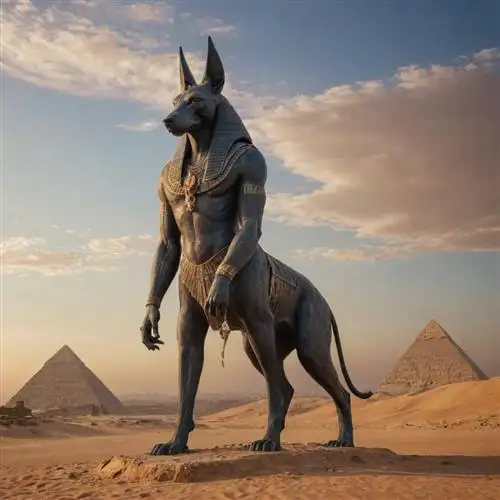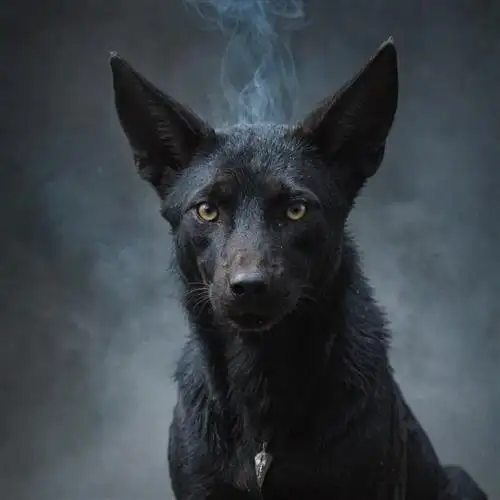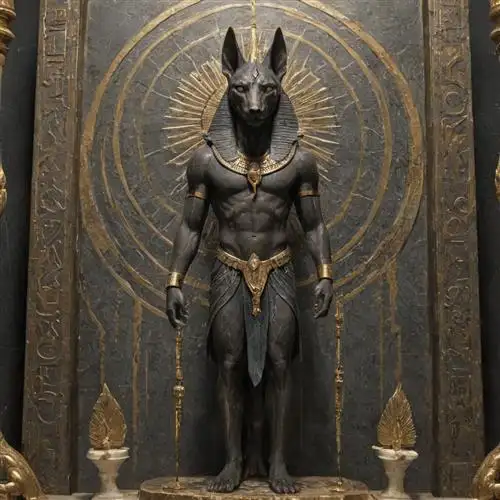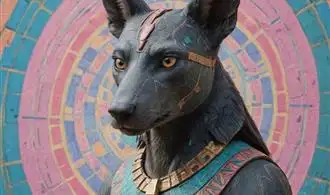
Anubis the Guardian of the Dead
Anubis, the enigmatic jackal-headed deity, has long been revered as the guardian of the dead in ancient Egyptian mythology. As a pivotal figure in the afterlife journey, Anubis' symbolism and role hold profound significance for those seeking to deepen their understanding of this captivating aspect of the ancient Egyptian pantheon.
At the heart of Anubis' significance lies his responsibility as the overseer of the mummification process. The ancient Egyptians believed that the deceased's journey to the afterlife was dependent on the proper preservation of the physical body. Anubis, with his keen knowledge of embalming techniques, was entrusted with this sacred duty, ensuring the deceased were prepared for their eternal rest. This role as the "Lord of the Funeral Rite" solidified Anubis' position as a crucial figure in the Egyptian afterlife.
Beyond his role in mummification, Anubis was also believed to guide the deceased through the treacherous underworld, navigating the challenges and obstacles that stood between the mortal realm and the realm of the dead. This depiction of Anubis as a psychopomp, or "conductor of souls," highlights his importance as a protector and companion for the departed. His presence at the scales of judgment, where the heart of the deceased was weighed against the feather of Ma'at (the goddess of truth and justice), further solidified his role as a guardian of the dead.
Interestingly, Anubis' jackal-like appearance held deep symbolic meaning for the ancient Egyptians. The jackal was believed to be a creature that could traverse the realms of the living and the dead, making Anubis an ideal intermediary between the two worlds. Additionally, the jackal's keen senses and ability to navigate the darkness of the underworld were seen as reflections of Anubis' own perceptive and vigilant nature.
The cult of Anubis was widespread throughout ancient Egypt, with numerous temples and shrines dedicated to the deity. These sacred spaces served as hubs for funerary rites and rituals, where the living could seek the guidance and protection of Anubis for their departed loved ones. The mummification process, which was carried out under Anubis' watchful eye, was a crucial component of these ceremonies, ensuring the deceased were properly prepared for the afterlife.
The Significance of Anubis Black Jackal Form
Anubis, the ancient Egyptian deity associated with the afterlife, is often depicted in his iconic black jackal form. This distinctive representation holds profound significance and symbolism within the rich tapestry of Egyptian mythology. The black jackal form of Anubis was not merely an artistic choice but rather a deliberate and deeply meaningful portrayal of the god's role and attributes.
The black color of Anubis' jackal form is particularly noteworthy. In ancient Egyptian cosmology, black was a color associated with the fertile soil of the Nile River, symbolizing regeneration, rebirth, and the cycle of life and death. By adopting this dark hue, Anubis was directly linked to the regenerative power of the earth, alluding to his role as the guardian of the deceased and the facilitator of their transition to the afterlife.
The jackal, as the physical form of Anubis, was also carefully selected to convey specific meanings. Jackals were often found near ancient Egyptian cemeteries and necropolis sites, scavenging the remains of the dead. This association with death and the afterlife made the jackal an ideal animal representation for Anubis, the god responsible for overseeing the mummification process and guiding the souls of the deceased to the underworld.
Moreover, the jackal's keen senses and ability to navigate the darkness of the night were seen as symbolic of Anubis' own perceptiveness and mastery of the liminal spaces between the world of the living and the dead. The jackal's nocturnal nature and connection to the underworld reinforced Anubis' role as the gatekeeper and protector of the deceased, guiding them through the treacherous journey to the afterlife.
In addition to the color and animal symbolism, the specific posture and positioning of Anubis in his jackal form hold deep significance. Anubis is often depicted sitting or standing, with his head tilted downward, a posture that conveys a sense of contemplation, focus, and reverence. This posture suggests Anubis' role as a thoughtful and attentive guardian, carefully overseeing the delicate process of mummification and the transition of the deceased to the afterlife.
Anubis Role in Mummification and Afterlife Rituals
Anubis, the jackal-headed Egyptian god, played a pivotal role in the rituals of mummification and the afterlife. As the god of the dead and the embalming process, Anubis was responsible for guiding the deceased through the intricate journey from this world to the next.
The mummification process, a complex and meticulous procedure, was essential in ancient Egyptian beliefs about the afterlife. Anubis oversaw each step, ensuring the proper preservation of the body and the preparation of the deceased for their eternal journey. The god's involvement in this process was not merely symbolic, but integral to the successful transition of the soul.
Anubis' role in the afterlife rituals was equally significant. The god was believed to be present during the weighing of the heart ceremony, where the deceased's heart was weighed against the feather of truth. If the heart was found to be pure, the individual would be granted access to the realm of the dead, where they would be welcomed by Anubis and the other deities.
Moreover, Anubis was responsible for guiding the deceased through the underworld, ensuring their safe passage to the afterlife. The god's presence was crucial in navigating the treacherous and often perilous journey, protecting the soul from the dangers that lurked in the shadows of the underworld.
In addition to his role in the mummification and afterlife rituals, Anubis was also believed to be the patron of embalmers and funeral directors. The god's influence extended beyond the spiritual realm, as he was revered for his expertise in the practical aspects of preparing the dead for their eternal rest.
Symbolism of Anubis Weighing the Heart Ceremony
The Symbolism of Anubis Weighing the Heart Ceremony is a captivating and intricate aspect of ancient Egyptian mythology. Anubis, the jackal-headed god, played a pivotal role in this sacred ritual, which determined the fate of the deceased in the afterlife.
At the heart of this ceremony was the weighing of the heart against the feather of Ma'at, the goddess of truth and justice. This process represented the moral and ethical judgement of the individual, as their heart was weighed against the standard of truth and righteousness. If the heart was found to be heavier than the feather, it was deemed unworthy, and the individual would face the devouring of their soul by the demon Ammit.
Anubis, the god of embalming and the protector of the dead, was responsible for conducting this critical examination. His jackal-like appearance was symbolic of his role as the guardian of the necropolis, the realm of the dead. Anubis would carefully place the heart of the deceased on one side of the scale, and the feather of Ma'at on the other, meticulously observing the balance between the two.
The significance of this ceremony cannot be overstated. It underscored the ancient Egyptians' belief in the importance of living a virtuous and truthful life, as the fate of the soul in the afterlife depended on the outcome of the weighing. The heart, representing the essence of the individual, was scrutinized for its purity and adherence to the principles of Ma'at.
The imagery associated with Anubis during the weighing of the heart ceremony is both powerful and symbolic. The jackal-headed god, with his black fur and piercing gaze, symbolized the transition between the world of the living and the realm of the dead. His presence at the moment of judgement signified the gravity and importance of the proceedings, as the individual's very existence in the afterlife hung in the balance.
Furthermore, the use of the scale, with the heart on one side and the feather of Ma'at on the other, represented the delicate balance between the individual's actions and the universal principles of truth and justice. This visual metaphor underscored the idea that one's life was constantly being weighed and measured against the standards of the divine.
The Connection between Anubis and Anput the Jackal Goddess
In ancient Egyptian mythology, Anubis and Anput shared a profound connection, both being associated with the jackal. Anubis, the god of the dead, was often depicted with the head of a jackal, while Anput, the female counterpart of Anubis, was also closely tied to the same animal. This symbolic relationship between the two deities holds deep significance in understanding the ancient Egyptian belief system.
Anubis, the jackal-headed god, was responsible for the embalming process and guiding the dead to the afterlife. He was considered the patron of cemeteries and the protector of the dead. Anput, on the other hand, was often depicted as a woman with the head of a jackal or a woman wearing a headdress adorned with the image of a jackal. She was the female counterpart of Anubis and was associated with the same funerary and mortuary functions.
The connection between Anubis and Anput can be seen in their shared attributes and roles. Both were believed to be guardians of the dead, overseeing the process of mummification and the journey of the deceased to the afterlife. In some ancient Egyptian texts, Anput is referred to as the "Female Anubis," further emphasizing their close relationship.
Additionally, the jackal was revered in ancient Egyptian culture for its keen senses and ability to navigate the desert landscape. This symbolic association with the jackal reinforced the connection between Anubis and Anput, as they were both seen as guides and protectors in the transition from life to death.
The significance of the Anubis-Anput relationship extends beyond their shared attributes and roles. In some ancient Egyptian temples, Anubis and Anput were worshipped together, with joint rituals and offerings made to honor their dual aspects of the afterlife and the funerary process. This joint veneration suggests a deeply intertwined relationship between the two deities, further emphasizing their importance in the ancient Egyptian belief system.















